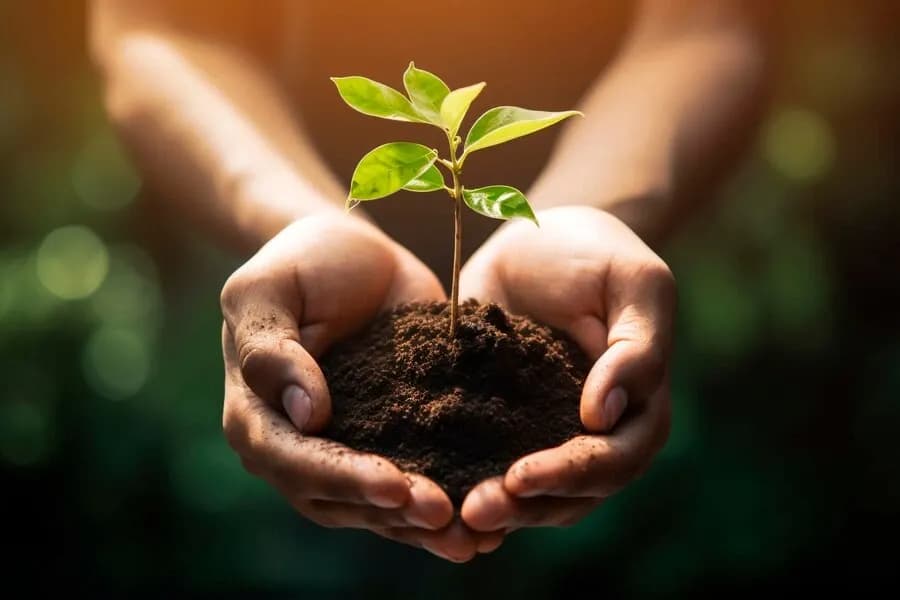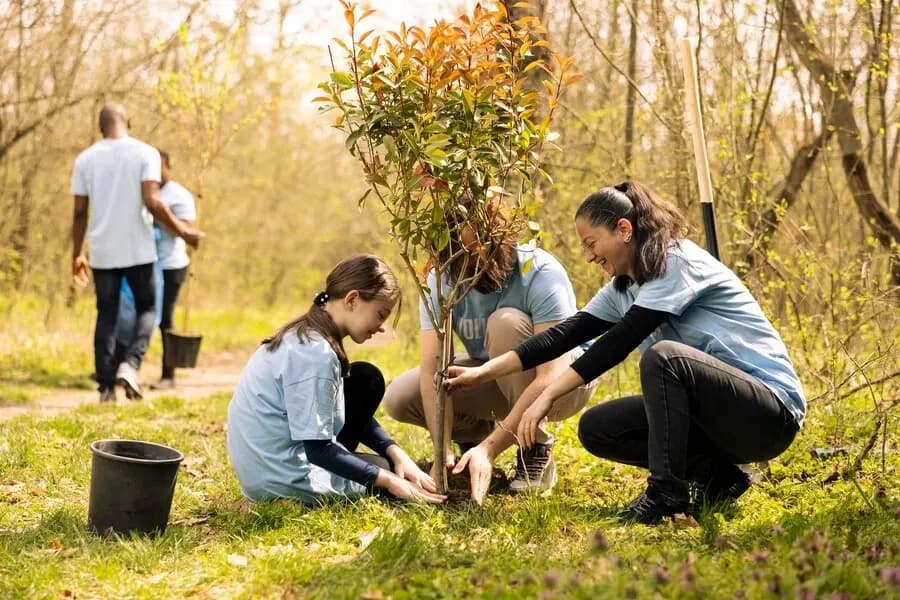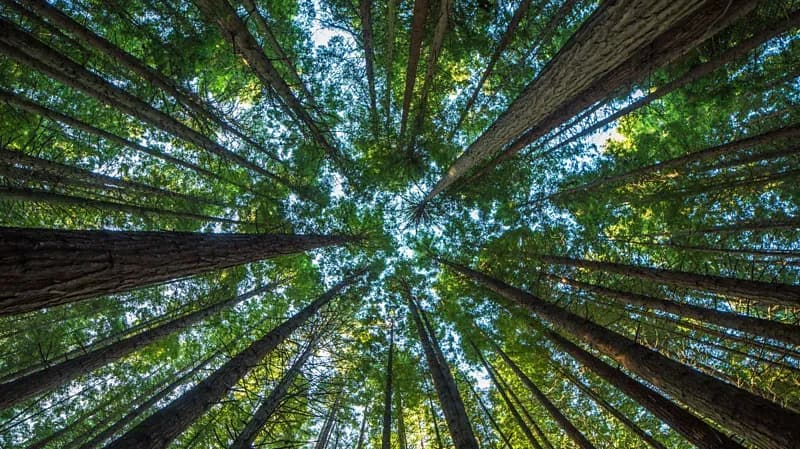Trees are more than just a part of the natural landscape. They serve as the backbone of ecosystems, contribute to economic stability, and combat the global climate crisis. In the Indian context, where rapid urbanization and industrialization are pressing challenges, the role of trees is critical for sustainable development. This blog explores the multifaceted importance of trees, providing scientific insights, global examples, and actionable knowledge for a broad audience.
1. Trees as the Earth’s Lungs
Trees absorb carbon dioxide (CO₂) and release oxygen (O₂) through photosynthesis, making them crucial for life on Earth. A mature tree can absorb 48 pounds of CO₂ annually and produce enough oxygen for four people daily. In India, deforestation is a major issue, with the country losing 132,000 hectares of forest cover annually (Global Forest Watch, 2023). This exacerbates climate challenges, especially in densely populated regions like Delhi, where air quality often reaches hazardous levels.
Key Fact:
The Miyawaki method of afforestation, widely adopted in India, has been effective in creating urban dense forests in places like Pune and Bengaluru. Such forests not only sequester CO₂ but also reduce urban heat by 2°C to 5°C.
2. Combatting Climate Change
Trees act as carbon sinks, reducing greenhouse gas concentrations. They also influence local weather patterns by transpiring water, which cools the atmosphere. In India, mangrove forests in Sundarbans have shielded the region from cyclones, absorbing 5.5 million tonnes of CO₂ annually (WWF India).
Scientific Insight:
The Indian forest ecosystem contributes approximately 1.5% of the national GDP through ecosystem services like carbon sequestration and soil conservation (TERI, 2021).
3. Enhancing Biodiversity
India, home to 8% of the world’s biodiversity.), relies on forests for the survival of species like the Bengal tiger, Asiatic elephant, and Indian pangolin. Trees provide habitats and food for these species, forming intricate ecosystems. Native species like the neem, banyan, and sal (Shorea robusta) are vital for maintaining India's ecological balance.
Example:
The Chipko Movement in Uttarakhand (1970s) demonstrated how local communities protected forests to conserve biodiversity, emphasizing the social and ecological importance of trees.

4. Economic and Livelihood Benefits
Forests in India support 275 million people, particularly tribal and rural communities, by providing timber, fuelwood, and non-timber forest products (NTFPs) like honey, medicinal plants, and bamboo. The bamboo industry alone employs over 9 million people, contributing significantly to rural economies.
Global Context:
Countries like Costa Rica have demonstrated the economic potential of forests through eco-tourism, generating $4 billion annually while maintaining 52% forest cover.
5. Urban Trees for Better Living
Urban green spaces play a vital role in improving the quality of life. Trees in cities reduce noise pollution, filter particulate matter, and lower ambient temperatures. For example, a study in Hyderabad revealed that neighborhoods with dense tree cover reported 35% fewer respiratory issues than areas without trees.
Case Study:
The Aravalli Biodiversity Park in Gurugram, Haryana, has transformed a degraded mining site into a thriving green space, hosting over 300 native plant species and acting as a carbon sink for the region.
6. Preventing Soil Erosion and Improving Agriculture
Tree roots bind soil, preventing erosion and enhancing fertility. Agroforestry, where trees are grown alongside crops, has been practiced in India for centuries. Techniques like alley cropping with species like Gliricidia improve soil nitrogen levels and crop yields by 20%.
Example:
In Rajasthan, the khejri tree (Prosopis cineraria) is integral to the Thar Desert ecosystem, supporting local agriculture by enriching soil and providing shade.
7. Cultural and Spiritual Importance
In India, trees have profound cultural significance. The banyan tree is considered sacred and represents longevity, while peepal trees are believed to bring spiritual enlightenment. Festivals like Van Mahotsav, initiated in 1950, promote tree plantation and awareness across India.
Global Examples Reflecting the Importance of Trees

1. Amazon Rainforest – "The Lungs of the Earth" (South America)
The Amazon Rainforest spans nine countries, including Brazil, Peru, and Colombia, covering an area of 5.5 million square kilometers. It is home to 390 billion individual trees belonging to 16,000 species. This massive forest absorbs approximately 2 billion tonnes of CO₂ annually, regulating global weather patterns and preventing drastic climate changes. Unfortunately, deforestation in the Amazon has surged, with 1 million hectares lost in 2023 alone, emphasizing the need for global efforts to protect this vital ecosystem.
Lessons from the Amazon:
- Protecting tropical rainforests is crucial for maintaining biodiversity as they host 10% of the world’s known species.
- Reforestation projects like "Reforest Amazon" aim to restore degraded areas, proving that rehabilitation is possible with sustained effort.
2. The Great Green Wall Initiative (Africa)
The Great Green Wall is an ambitious project launched by the African Union in 2007. Its goal is to create an 8,000 km long wall of trees across the Sahel region, stretching from Senegal in the west to Djibouti in the east. This project combats desertification, restores degraded lands, and promotes sustainable livelihoods in one of the world’s most vulnerable regions.
Impact of the Great Green Wall:
- 18 million hectares of land restored to date.
- Sequestration of 4.9 million tonnes of CO₂ annually.
- Creation of jobs for 350,000 people in rural communities.
- Increase in agricultural productivity by providing natural barriers against wind and soil erosion.
3. Miyawaki Forests (Japan and Beyond)
Pioneered by Japanese botanist Dr. Akira Miyawaki, this technique emphasizes planting dense native forests that grow 10 times faster and are 30 times denser than traditional plantations. It has gained global popularity, with cities in India, the Netherlands, and the United States implementing Miyawaki forests to combat urban heat and promote biodiversity.
Case Study – Miyawaki in India:
- Cities like Pune and Bengaluru have adopted this method, creating micro-forests in urban areas, improving air quality, and reducing temperatures locally.
4. The Loess Plateau Restoration Project (China)
The Loess Plateau in northern China was once a degraded area suffering from severe soil erosion and desertification. Over 20 years, a massive restoration project involving tree planting transformed the plateau into fertile land. This initiative, supported by the World Bank, involved planting fruit-bearing trees and native vegetation to stabilize soil and promote local agriculture.
Key Achievements:
- The area’s forest cover increased by 35%.
- Annual grain yields doubled, supporting food security for millions.
- The project has become a global example of how degraded ecosystems can be revived through large-scale afforestation.
5. Copenhagen – Tree-Centric Urban Planning (Denmark)
Copenhagen has integrated trees into its urban planning to tackle climate change and enhance the quality of life. The city aims to plant 100,000 trees by 2025 as part of its carbon-neutral goals.
Highlights:
- Urban trees in Copenhagen reduce flooding risks by absorbing rainwater during heavy rains.
- Citizens enjoy the cooling effects of green spaces, with areas under tree cover being 5°C cooler than surrounding concrete zones.
- The city’s emphasis on green corridors connects parks and forests, creating an ecosystem that supports urban wildlife.
6. The Billion Tree Tsunami (Pakistan)
Launched in 2014, this ambitious project aimed to restore degraded forests and increase tree cover in Pakistan’s Khyber Pakhtunkhwa province. By 2021, the project achieved its target of planting over 1 billion trees.
Impact of the Billion Tree Tsunami:
- Recovery of 350,000 hectares of forest and degraded land.
- Reduction in the risk of flash floods, which are common in mountainous regions.
- Improved livelihoods for local communities through eco-tourism and forest-based jobs.

7. New York City’s “Million Trees NYC” (United States)
This initiative, launched in 2007, aimed to plant 1 million trees across New York City by 2017. The program achieved its goal two years ahead of schedule, enhancing urban greenery and resilience against climate change.
Benefits:
- Reduction in urban heat island effects, with neighborhoods gaining cooler microclimates.
- Air quality improvement, with a 10% reduction in particulate pollution in areas with higher tree density.
- Enhanced community well-being, with green spaces linked to lower stress levels and improved mental health.
8. Agroforestry Success in Costa Rica
Costa Rica, known for its high forest cover (52%), has successfully integrated trees into agriculture through agroforestry practices. Farmers grow crops like coffee and cocoa under tree canopies, creating a symbiotic relationship between agriculture and forests.
Key Outcomes:
- Increase in coffee yields by 20% due to shaded cultivation.
- Protection of water sources, as tree roots help maintain aquifers.
- Promotion of eco-tourism, which generates $4 billion annually, highlighting the economic value of preserving forests.
9. The Sacred Groves of Meghalaya (India)
In India, the Khasi and Jaintia tribes in Meghalaya have preserved sacred groves for centuries. These groves, protected by traditional beliefs, serve as biodiversity hotspots, hosting rare species of plants, animals, and fungi.
Significance:
- Sacred groves demonstrate the integration of cultural practices with ecological conservation.
- They act as genetic reservoirs for native flora, which may have medicinal or agricultural value in the future.
10. The Redwood Forests of California (United States)
The coastal redwoods in California are among the tallest and oldest trees globally, some over 2,000 years old. These trees play a critical role in carbon storage, with a single redwood sequestering 250 tonnes of CO₂ over its lifetime.
Current Efforts:
- Organizations like Save the Redwoods League focus on restoring logged areas and protecting remaining ancient forests.
- Eco-tourism in redwood forests generates millions in revenue annually, showcasing the intersection of conservation and economy.
Documentaries to Watch
-
“The True Cost of Forests” (Available on YouTube) Explores the economic and environmental costs of deforestation.
-
“Years of Living Dangerously” (National Geographic) Highlights the link between climate change and deforestation, featuring stories from India.
-
“Call of the Forest: The Forgotten Wisdom of Trees” (Amazon Prime Video) Examines how native forests support life globally.
-
“The Man Who Planted Trees” (YouTube) A short animated film about the transformative power of tree planting.
Actionable Steps to Protect and Promote Trees

-
Support Afforestation Projects: Contribute to initiatives like the CATCH Foundation's dense forest plantations.
-
Adopt Native Species: Plant trees like neem, tamarind, and amla, which are well-suited to Indian conditions.
-
Educate and Advocate: Promote awareness through schools and community programs.
-
Participate in Citizen Science: Contribute to tree mapping and biodiversity surveys using apps like iNaturalist.
Conclusion
Trees are indispensable to our survival, offering environmental, economic, and cultural benefits. In India, where population pressure is immense, conserving and planting trees is no longer a choice but a necessity. From global carbon regulation to enhancing biodiversity, the importance of trees transcends borders. By taking individual and collective action, we can ensure a greener and more sustainable future.
References
-
Global Forest Watch (2023) https://www.globalforestwatch.org/
-
WWF India - Mangrove Carbon Sequestration (2021) https://www.wwfindia.org/
-
The Energy and Resources Institute (TERI) (2021) https://www.teriin.org/
-
Ministry of Environment, Forest and Climate Change (MoEFCC), India https://moef.gov.in/
By valuing and protecting trees, we safeguard our planet for generations to come. Let’s act now.
